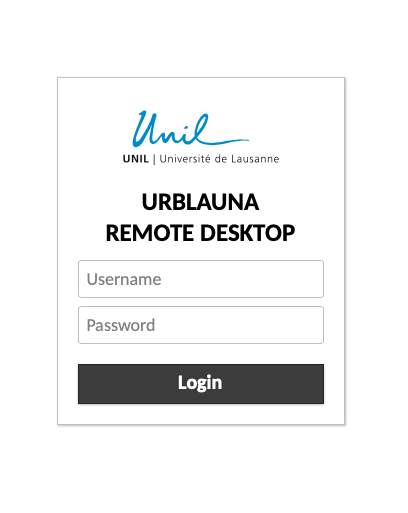Urblauna migration
Urblauna
Urblauna is the new UNIL cluster for sensitive data and will replace the Jura cluster.
stockage-horus is the name used for the Jura cluster when connecting from the CHUV.
Note: "HORUS" is an acronym for HOspital Research Unified data and analytics Services
Documentation
As well as this page there is documentation at:
https://wiki.unil.ch/ci/books/high-performance-computing-hpc/page/urblauna-access-and-data-transfer
https://wiki.unil.ch/ci/books/high-performance-computing-hpc/page/jura-to-urblauna-migration
https://wiki.unil.ch/ci/books/high-performance-computing-hpc/page/urblauna-guacamole-rdp-issues
Nearly all the documentation for Curnagl is also applicable.
The introductory course for using the clusters is available HERE
The slides for our other courses can be consulted HERE
Support
Please contact the DCSR via helpdesk@unil.ch and start the mail subject with "DCSR Urblauna"
Do not send mails to dcsr-support - they will be ignored.
Specifications
- 18 compute nodes
- 48 cores / 1 TB memory per node
- 2 nodes with NVidia A100 GPUs
- 1PB /data filesystem
- 75TB SSD based /scratch
For those of you have already used Curnagl then things will be very familiar.
If the initial resources are found to be insufficient then more capacity can be easily added.
An Urblauna looks like:
How to connect
For Jura the connection method is different depending on if one connects from the CHUV or the UNIL networks - for Urblauna it's the same for everyone.
Two Factor Authentication
You should have received a QR code which allows you to setup the 2FA - if you lose your code then let us know and we will generate a new one for you.
SSH
% ssh ulambda@u-ssh.dcsr.unil.ch
(ulambda@u-ssh.dcsr.unil.ch) Password:
(ulambda@u-ssh.dcsr.unil.ch) Verification code:
Last login: Wed Jan 18 13:25:46 2023 from 130.223.123.456
[ulambda@urblauna ~]$
The 2FA code is cached for 1 hour in case that you connect again.
X11 Forwarding and SSH tunnels are blocked as is SCP
Web
Go to u-web.dcsr.unil.ch and you will be asked for your username and password followed by the 2FA code:
This will send you to a web based graphical desktop that should be familiar for those who already access jura.dcsr.unil.ch
Data Transfer
The principle method to get data in/our of Urblauna is using the SFTP protocol
On Urblauna your /scratch/<username> space is used at the buffer when transferring data.
% sftp ulambda@u-sftp.dcsr.unil.ch
(ulambda@u-sftp.dcsr.unil.ch) Password:
(ulambda@u-sftp.dcsr.unil.ch) Verification code:
Connected to u-sftp.dcsr.unil.ch.
sftp> pwd
Remote working directory: /ulambda
sftp> put mydata.tar.gz
Uploading mydata.tar.gz to /ulambda/mydata.tar.gz
The file will then be visible from urblauna at /scratch/ulambda/mydata.tar.gz
For graphical clients such as Filezilla you need to use the interactive login type so as to be able to enter the 2FA code.
Coming soon
There will be an SFTP endpoint u-archive.dcsr.unil.ch that will allows transfer to the /archive filesystem without 2FA from specific IP addresses at the CHUV.
This is on request and must be validated by the CHUV security team.
What's new
There are a number of changes between Jura and Urblauna that you need to be aware of:
GPUs
There are two GPU equiped nodes in Urblauna and each A100 card has been partitioned so as to provide a total of 8 GPUs with 20GB of memory.
To request a GPU use the --gres Slurm directive
#SBATCH --gres gpu:1
/data
The /data filesystem is structured in the same way as on Jura but it is not the same filesystem
The initial quotas are the same as on Jura - if you wish to increase the limit then just ask us.
The Jura /data filesystem is available in read-only at /jura_data
/scratch
Unlike on Jura /scratch is now organised per user as on Curnagl and as it is considered as temporary space there is no fee associated.
There are no quotas but in case of the utilisation being greater that 90% then files older than 2 weeks will be removed automatically.
/users
The /users home directory filesystem is also new - the Jura home directories can be accessed in read-only at /jura_home.
/work
The Curnagl /work filesystem is visible in read-only from inside Urblauna. This is very useful for being able to install software on an Internet connected system.
/archive
This is exactly the same /archive as on Jura!
The DCSR software stack
This is now the default stack and is identical to Curnagl. It is still possible to use the old Vital-IT /software but this is deprectaed.
For how to do this see the documentation at Old software stack
There's lots of information on how to use this in our introductory course
Installing your own software
We encourage you to ask for a project on Curnagl (HPC normal data) which will allow you to install tools and then be able to use them directly inside Urblauna.
See the documentation for further details
For those who use Conda don't forget to make sure that all the directories are on you project /work space
https://wiki.unil.ch/ci/books/high-performance-computing-hpc/page/using-conda-and-anaconda
nano .condarc
pkgs_dirs:
- /work/path/to/my/project/space
envs_dirs:
- /work/path/to/my/project/space
Jura decommissioning
Urblauna provides a generational leap in performance and capacity compared to Jura so we hope that the interest to migrate is obvious.
The exact timeline for taking Jura offline is still to be defined but we expect that the data will be available for at least six months following the introduction of Urblauna.
Please be aware that Jura is now deprecated and only minimal support will be provided.
If you need help transferring your workflows from Jura to Urblauna then just ask us!


